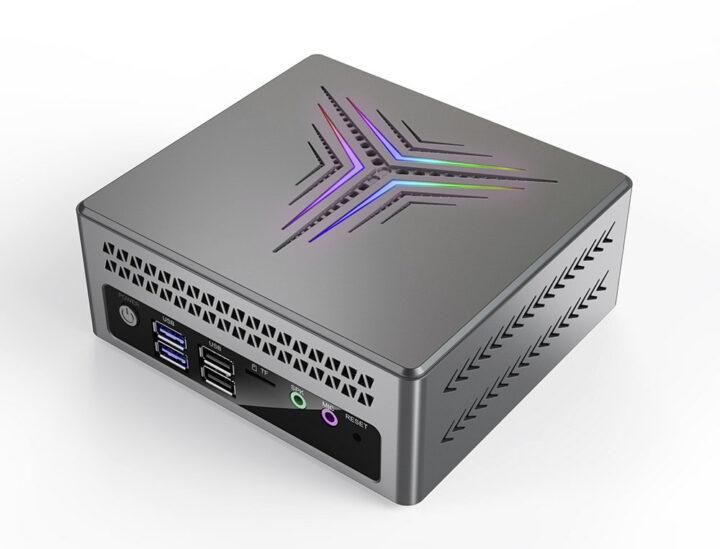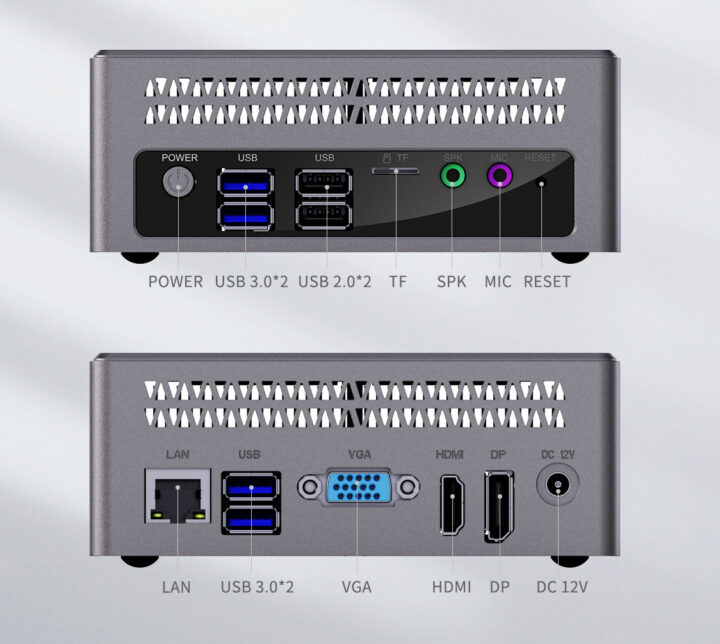Intel Jasper Lake N-Series Celeron and Pentium processors were formally introduced at the beginning of the year as the successors of the Gemini Lake (Refresh) processors, and we’ve seen several mini PCs and motherboards so far from lesser-known Chinese manufacturers to more established brands like ASUS, GIGABYTE, and ECS.
The previous generation Gemini Lake mini PCs would usually sell around $150 to $200, but now with the JK01 barebone computer, we’ve got an inexpensive Intel Celeron N5095 Jasper Lake mini PC selling for about $141 including shipping.
 CYX JK01 mini PC specifications:
CYX JK01 mini PC specifications:
- SoC – Intel Celeron N5095 quad-core Jasper Lake processor @ 2.0GHz / 2.9GHz (Turbo) with 4MB cache, 16EU Intel UHD Graphics; 15W TDP
- System Memory – 2x SO-DIMM slots for up to 16GB DDR4 memory
- Storage – M.2 2280 socket for NVMe or SATA SSD, 2.5-inch SATA drive bay, MicroSD card socket
- Video Output – 1x HDMI 2.0 port up to 4Kp60, 1x DisplayPort port up to 4Kp60, 1x VGA port; three independent display support
- Audio – 3.5mm Line out/speaker jack, 3.5mm microphone jack, digital audio via HDMI
- Connectivity
- Gigabit Ethernet RJ45 port via RTL8111F chip
- Optional Dual-band 802.11 b/g/n/ac WiFi 5 and Bluetooth 4.2 via M.2 2230 module
- USB – 4x USB 3.0 ports, 2x USB 2.0 ports, 1x USB-C port
- Misc
- Power & Reset buttons
- Hardware monitoring – CPU temperature, system temperature, onboard voltage, watchdog
- AMI UEFI BIOS on 8MB flash
- Power Supply – 12V/2.5A DC jack
- Dimensions – 140 x 140 x 47 mm (specs) or 136 x 125 x 52 mm (graphics). IMHO, the second one looks right…
The system is actively cooled and the company says it supports Windows 64-bit and Linux 64-bit operating systems. The seller also offers full systems with memory, storage, and Windows 10 Pro 64-bit pre-installed, although possibly not activated:
- $199 – 8GB RAM, 128GB NVMe SSD
- $219 – 8GB RAM, 256GB NVMe SSD
- $238 – 8GB RAM, 512GB NVMe SSD
- S325 – 16GB RAM, 512GB NVMe SSD
If you’d like to get an idea of the performance, you can check out Ian’s review of Beelink U59 mini PC also based on the Intel Celeron N5095 processor, and tested with Windows 11 and Ubuntu 20.04/21.04. Note there will always be some small variation between systems with the same processor, either because of cooling, memory configuration/bandwidth, or storage (SSD vs SATA), but it can still serve as a rough guide of expected performance.
Via Liliputing

Jean-Luc started CNX Software in 2010 as a part-time endeavor, before quitting his job as a software engineering manager, and starting to write daily news, and reviews full time later in 2011.
Support CNX Software! Donate via cryptocurrencies, become a Patron on Patreon, or purchase goods on Amazon or Aliexpress. We also use affiliate links in articles to earn commissions if you make a purchase after clicking on those links.





> Gigabit Ethernet RJ45 port via RTL8111F
That’s close to a deal breaker. At least i wouldn’t buy anything using RTL8111 prior to revision G/H (details here on this blog). But as always: it all depends on the use case…
And it’s the 15w TDP SoC used here. I’d rather go for N5105 10W. I heard from a Chinese manufacturer that Jasper Lakes rather get hot. And it’s also the feedback from one Amazon.de user buying one mini PC with this 15w SoC.
If you don’t need the 2x SODIMM, there are Gigabyte Jasper Lake mini pcs at close to this price in Europe. IIRC I’ve seen at around 170€
Some experiences with a passively cooled Jasper Lake thing available in the comments section here. I guess this box here has a fan for a reason. As such I would never buy something like that without being able to listen to it upfront or read at least 20 reviews. At least if the use case implies having it in the same room as my ears.
Interesting comments. I’ve read some of the comments you link to , but i see a lot of updates there now.
Here is the one i’ve found so far: https://amzn.to/3lSJfaI
This one is actively cooled with a fan, but obviously it’s too loud to sit next to it.
It’s the same N6000 SoC as the one used by feedback at https://www.cnx-software.com/2021/10/15/2-5gbe-mini-pc-asus-pn41/#comment-585962
I am considering N6005 and N6415, but after reading these feedback i am not so sure.
The node process shrank from 14nm to 10nm for Jasper Lakes, but there is heat issues!
I guess i have to consolidate more workload into HP t740 🙂
Not much interested either, for the same reasons. I’m not going to refresh a fanless 11yr-old N450 that is still doing its job well by replacing it by something that consumes twice as much power, has less I/O and makes noise 🙂
Here are some info of a passively cooled Jasper Lake gigabyte brix with N4500. Sensors and powertop when idle with disabled wireless (rfkill).
Could you provide any pointers on what UEFI settings to adjust, as mentioned at your linked post?
I talked about numbers at a time when we did not adjust any UEFI settings. But it remained that way and we only changed irrelevant stuff there. At boot we’re running now ‘sleep 60 ; powertop –auto-tune’.
Something else changed and I can’t remember why: In the beginning there was no cpufreq support in Linux, now it’s somehow broken: 5 cpufreq OPP between 800 and 1101 MHz which clock all at 2.8GHz in reality.
I often see different real frequency and OPP on x86 in turbo mode, I *think* it’s when using acpi-cpufreq which ignores OPP and lets the firmware or BIOS do whatever it wants, but I’m not certain, because I seem to remember having seen it in the past with intel-pstate as well.
An UEFI update from ‘0802’ to ‘0803’ fixed everything. Now Intel P- and C-states ‘are available’, the Intel driver is in use, cpufreq is reported correctly and as a side effect the whole N5100 box (PSU included) now idles at 2.7W (0.8W less than before).
Am I correct about this:
Correct?
Lakefield is already EOL, Alder Lake is the new hot sh*t.
Alder Lake is it … thank you!
Lakefield was like a beta test of the big.LITTLE concept. Maybe an alpha test if you consider Alder Lake to be the beta test. It used 1 big Sunny Cove and 4 small Tremont (Atom) cores instead of the Golden Cove and Gracemont cores found in Alder Lake. Jasper Lake also uses Tremont.
Lakefield also used some fancy 3D packaged chiplets and DRAM and was hyped up as the future of mobile x86. It turned out to be very expensive but didn’t perform well at launch, perhaps because Windows couldn’t handle heterogeneous back then even with Intel and Microsoft both working together on it. Microsoft would go on to make a new major version of Windows almost exclusively for Alder Lake’s benefit, and it still has issues.
The Alder Lake ultra mobile 2+8 die has a 1+4 SKU that targets the exact same segment as Lakefield did, even though it has none of the 3D packaging tricks that supposedly lowered power consumption. You can search the following string to find the leaked chart on Notebookcheck:
M5 (5-7 W): Core i3 1C GLC + 4C GRT + 48 EU Xe | Core i5 1C GLC + 4C GRT + 64 EU Xe
That’s the M5, intended for tablets and other low-power (presumably fanless) form factors, occupying the same ~7W TDP that Lakefield did. Except it might be even more efficient, and it should have AVX/AVX2 support which was not present in Tremont and disabled in Lakefield!
Alder Lake 1+4+64EU or 2+8+96EU could make for some great mini PCs by adding much better single-thread performance from the big cores. The announcement might be on January 4 at CES, although it would take much longer to come to these Chinese mini PCs.